Lung cancer - small cell
Cancer - lung - small cell; Small cell lung cancer; SCLC
Small cell lung cancer (SCLC) is a fast-growing type of lung cancer. It spreads much more quickly than non-small cell lung cancer.
There are two types of SCLC:
- Small cell carcinoma (oat cell cancer)
- Combined small cell carcinoma
Most SCLCs are of the oat cell type.

Bronchoscopy is a surgical technique for viewing the interior of the airways. Using sophisticated flexible fiber optic instruments, surgeons are able to explore the trachea, main stem bronchi, and some of the small bronchi. In children, this procedure may be used to remove foreign objects that have been inhaled. In adults, the procedure is most often used to take samples of (biopsy) suspicious lesions and for culturing specific areas in the lung.

The major features of the lungs include the bronchi, the bronchioles and the alveoli. The alveoli are the microscopic blood vessel-lined sacks in which oxygen and carbon dioxide gas are exchanged.

A lateral view of a chest x-ray in a patient with central cancer of the lung.

A chest x-ray in a patient with central cancer of the right lung. Notice the white mass in the middle portion of the right lung (seen on the left side of the picture).

This chest x-ray shows adenocarcinoma of the lung. There is a rounded light spot in the right upper lung (left side of the picture) at the level of the second rib. The light spot has irregular and poorly defined borders and is not uniform in density. Diseases that may cause this type of x-ray result would be tuberculous or fungal granuloma, and malignant or benign tumors.

This chest CT scan shows a cross-section of a person with bronchial cancer. The two dark areas are the lungs. The light areas within the lungs represent the cancer.

This is a chest x-ray of a person with bronchial cancer. This is a front view. The lungs are the two dark areas. The heart and other structures are white areas visible in the middle of the chest. The light areas that appear as subtle branches extending from the center into the lungs are cancerous.

This CT scan shows a cross section of the lungs of a person with lung cancer. The two dark areas in the middle of the screen are the lungs. The light areas in the right lung (on the left of the screen) represent the cancer.
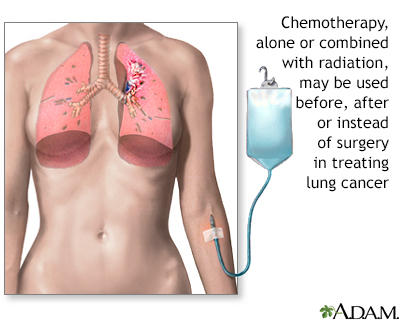
Treatment for lung cancer depends on the type of cancer and the stage of the disease. Chemotherapy is a form of treatment for lung cancer which may cure, shrink or keep the cancer from spreading.
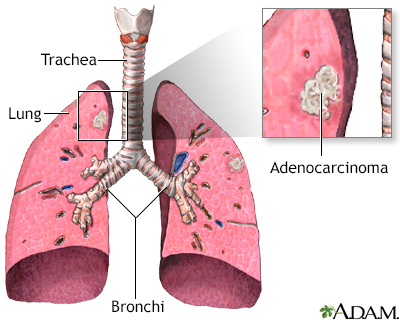
Adenocarcinoma usually develops on the outer boundaries of the lungs and is more commonly found in women than in men.
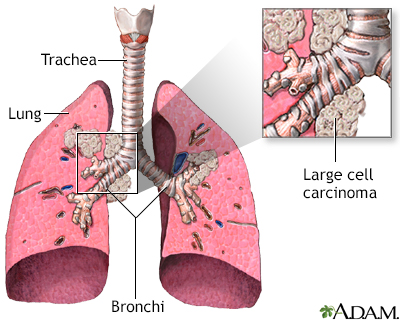
Non-small cell carcinomas are the most common lung cancers.
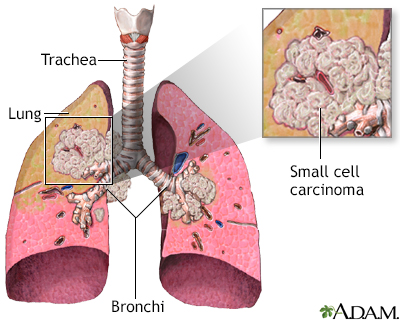
Small cell carcinoma, also called oat cell carcinoma, can create its own hormones, which alter body chemistry.
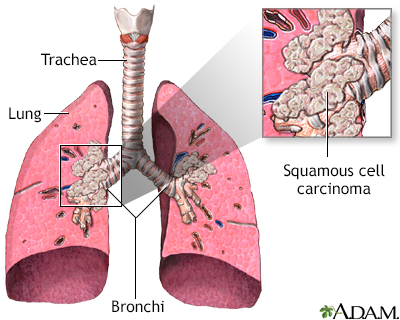
Squamous cell carcinoma commonly starts in the bronchi and may not spread as rapidly as other lung cancers.
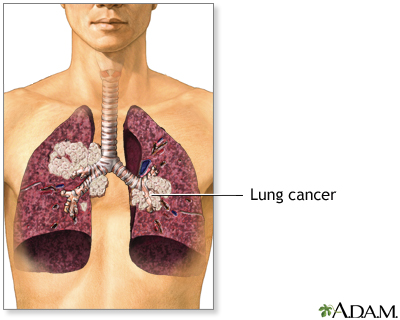
Secondhand smoke has been classified as a known cause of lung cancer in humans (Group A carcinogen).
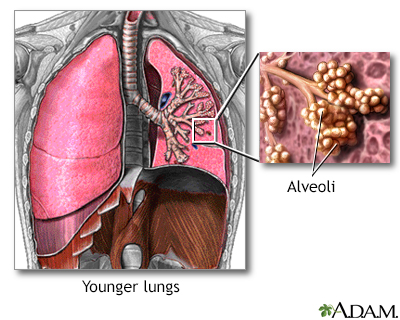
The lungs are located in the chest cavity and are responsible for respiration. The alveoli are small sir sacs where oxygen is exchanged in the lungs.

Air is breathed in through the nasal passageways, travels through the trachea and bronchi to the lungs.
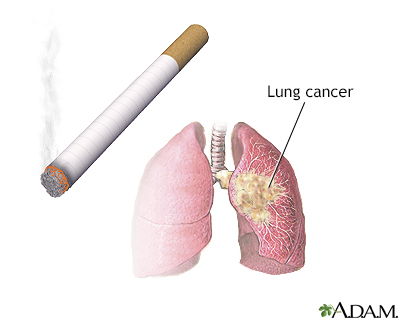
Smoking cigarettes puts a person at risk for emphysema, lung cancer and other health problems. Second-hand smoke (smoke from a nearby cigarette) may also contribute to these diseases, especially among children.
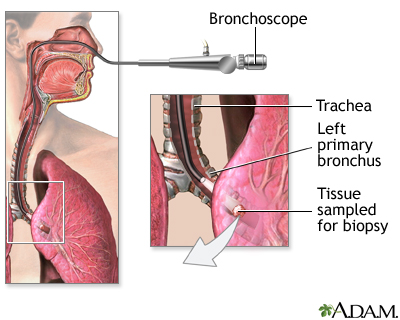
Lung or bronchial biopsy (tissue samples taken to diagnose or rule out disease) may be done with the use of a flexible bronchoscope, an instrument with a small light and camera which is inserted through the nose or mouth. When a suspicious area is seen, an instrument is channeled through the bronchoscope to take a sample for analysis.
Causes
About 15% of all lung cancer cases are SCLC. Small cell lung cancer is slightly more common in men than women.
Almost all cases of SCLC are due to cigarette smoking. SCLC is very rare in people who have never smoked.
SCLC is the most aggressive form of lung cancer. It usually starts in the breathing tubes (bronchi) in the center of the chest. Although the cancer cells are small, they grow very quickly and create large tumors. These tumors often spread rapidly (metastasize) to other parts of the body, including the brain, liver, and bone.
Symptoms
Symptoms of SCLC include:
- Bloody sputum (phlegm)
- Chest pain
- Cough
- Loss of appetite
- Shortness of breath
- Weight loss
- Wheezing
Other symptoms that may occur with this disease, especially in the late stages, include:
- Facial swelling
- Fever
- Hoarseness or changing voice
- Swallowing difficulty
- Weakness
Exams and Tests
Your health care provider will perform a physical exam and ask about your medical history. You will be asked whether you smoke, and if so, how much and for how long.
When listening to your chest with a stethoscope, your provider may hear fluid around the lungs or areas where the lung has partially collapsed. Each of these findings may suggest cancer.
SCLC has usually spread to other parts of your body by the time it is diagnosed.
Tests that may be performed include:
- Bone scan
- Chest x-ray
- Complete blood count (CBC)
- CT scan
- Liver function tests
- MRI scan
- Positron emission tomography (PET) scan
- Sputum test (to look for cancer cells)
- Thoracentesis (removal of fluid from the chest cavity around the lungs)
In most cases, a piece of tissue is removed from your lungs or other areas to be examined under a microscope. This is called a biopsy. There are several ways to do a biopsy:
- Bronchoscopy combined with biopsy
- CT scan-directed needle biopsy
- Endoscopic esophageal or bronchial ultrasound with biopsy
- Mediastinoscopy with biopsy
- Open lung biopsy
- Pleural biopsy
- Video-assisted thoracoscopy
Usually, if a biopsy shows cancer, more imaging tests are done to find out the stage of the cancer. Stage means how big the tumor is and how far it has spread. SCLC is classified as either:
- Limited -- Cancer is only in the chest and can be treated with radiation therapy.
- Extensive -- Cancer has spread outside the area that can be covered by radiation therapy.
Treatment
Because SCLC spreads quickly throughout the body, treatment will include cancer-killing drugs (chemotherapy), which are usually given through a vein (by IV).
Treatment with chemotherapy and immunotherapy, and possibly radiation, may be done for people with SCLC that has spread throughout the body (extensive). In this case, the treatment only helps relieve symptoms and prolongs life, but does not cure the disease.
Radiation therapy can be used with chemotherapy if the disease is confined to one area within the chest (limited).
Radiation therapy uses powerful x-rays or other forms of radiation to kill cancer cells.
Radiation may be used to:
- Treat the cancer, along with chemotherapy, if surgery is not possible.
- Help relieve symptoms caused by the cancer, such as breathing problems and swelling.
- Help relieve cancer pain when the cancer has spread to the bones.
Often, SCLC may have already spread to the brain. This can occur even when there are no symptoms or other signs of cancer in the brain. As a result, some people with smaller cancers, or who had a good response in their first round of chemotherapy, may receive radiation therapy to the brain. This therapy is done to prevent spread of the cancer to the brain.
Surgery helps very few people with SCLC because the disease has often spread by the time it is diagnosed. Surgery may be done when there is only one tumor that has not spread. If surgery is done, chemotherapy or radiation therapy is still needed.
Support Groups
You can ease the stress of illness by joining a cancer support group. Sharing with others who have common experiences and problems can help you not feel alone.
Outlook (Prognosis)
How well you do depends on how much the lung cancer has spread. SCLC is very deadly. Not many people with this type of cancer are still alive 5 years after diagnosis.
Treatment can often prolong life to more than 12 months, even when the cancer has spread.
In rare cases, if SCLC is diagnosed early, treatment may result in a long-term cure.
When to Contact a Medical Professional
Contact your provider if you have symptoms of lung cancer, particularly if you smoke.
Prevention
If you smoke, now is the time to quit. If you are having trouble quitting, talk with your provider. There are many methods to help you quit, from support groups to prescription medicines. Also try to avoid secondhand smoke.
If you smoke or used to smoke, talk with your provider about getting screened for lung cancer. To get screened, you need to have a CT scan of the chest.
References
Araujo LH, Horn L, Merritt RE, Shilo K, Xu-Welliver M, Carbone DP. Cancer of the lung: non-small cell lung cancer and small cell lung cancer. In: Niederhuber JE, Armitage JO, Kastan MB, Doroshow JH, Tepper JE, eds. Abeloff's Clinical Oncology. 6th ed. Philadelphia, PA: Elsevier; 2020:chap 69.
National Comprehensive Cancer Network website. NCCN clinical practice guidelines in oncology: Small cell lung cancer. Version 1.2024.
National Cancer Institute website. Small cell lung cancer treatment (PDQ) - health professional version.
Rivera MP, Mody GN, Weiner AA. Lung cancer: treatment. In: Broaddus VC, Ernst JD, Talmadge EK, et al, eds. Murray and Nadel's Textbook of Respiratory Medicine. 7th ed. Philadelphia, PA: Elsevier; 2022:chap 77.
Version Info
Last reviewed on: 8/28/2023
Reviewed by: Todd Gersten, MD, Hematology/Oncology, Florida Cancer Specialists & Research Institute, Wellington, FL. Review provided by VeriMed Healthcare Network. Also reviewed by David C. Dugdale, MD, Medical Director, Brenda Conaway, Editorial Director, and the A.D.A.M. Editorial team.
